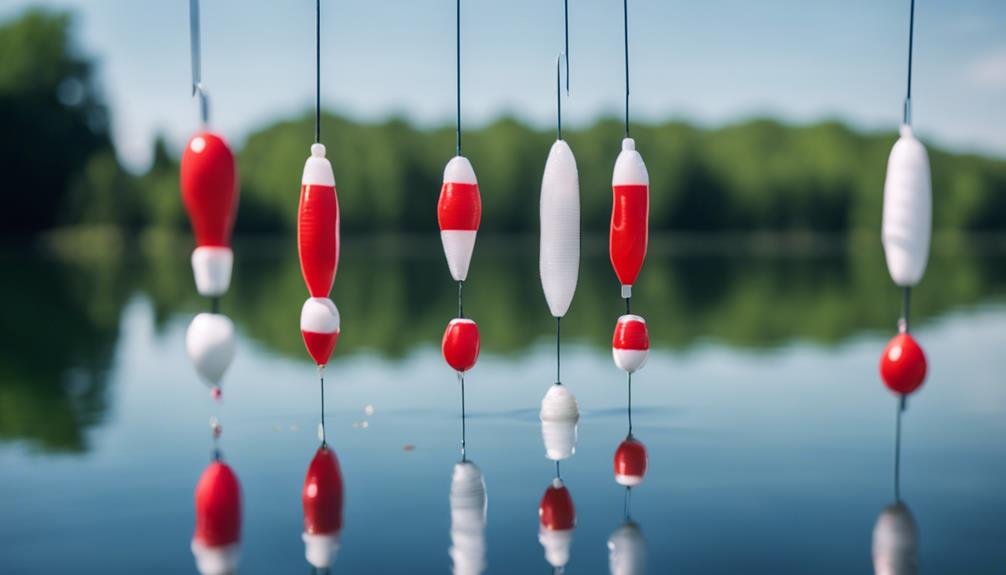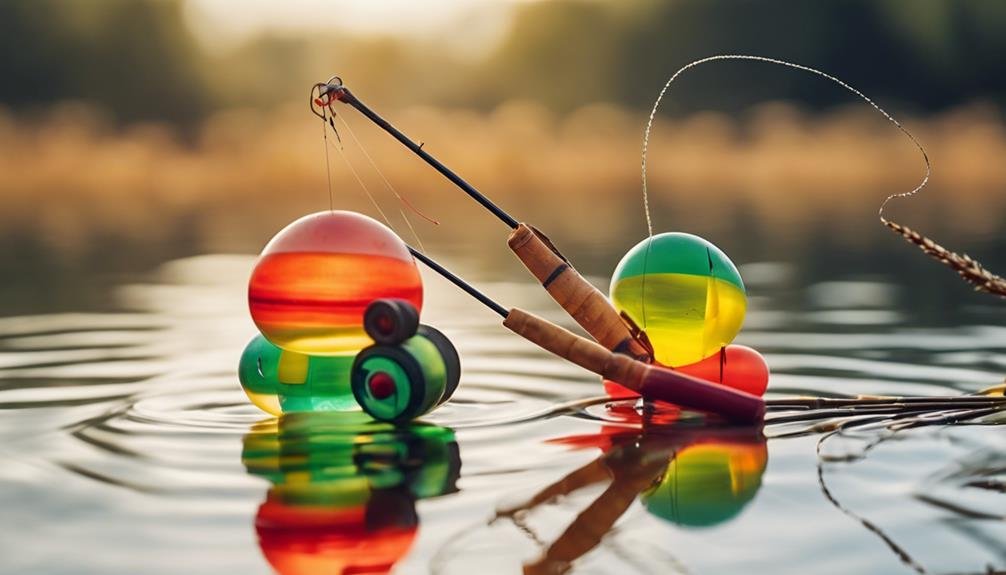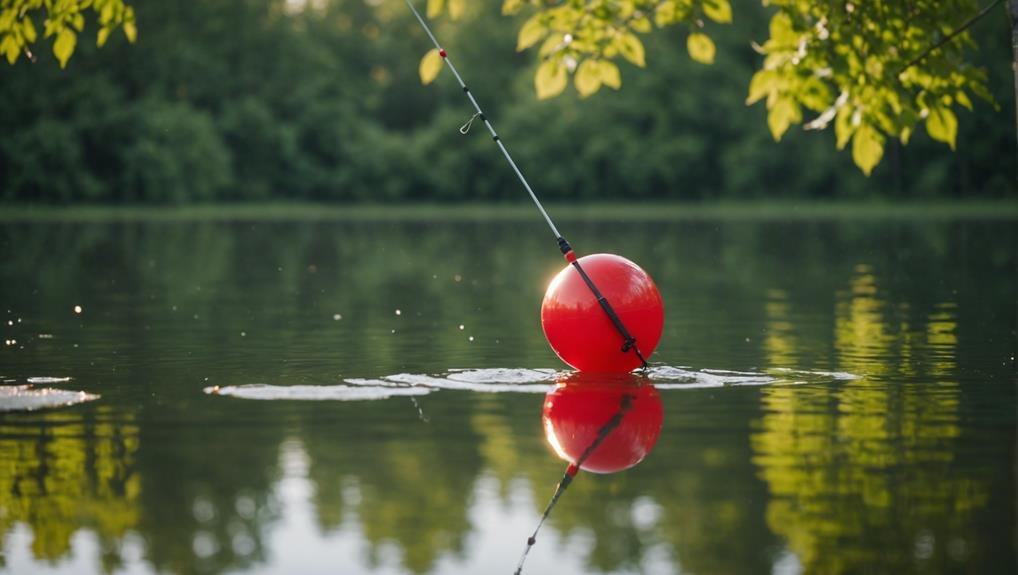When you think about enhancing your fishing game, a fishing bobber is an indispensable tool that shouldn’t be overlooked. Whether dealing with the intricate depths of slip bobbers or the straightforward nature of fixed ones, each type has advantages tailored to specific fishing environments. But how exactly do you attach a bobber, and what factors should you consider when choosing one? By mastering these aspects, you’ll greatly improve your visibility and bite detection, making each fishing trip more successful. So, what should you know to get started?
Key Takeaways
- Slip bobbers are best for fishing in deeper waters due to their precise depth control.
- Fixed bobbers are ideal for fishing in shallow waters and are easy to use.
- Foam floats are buoyant, durable, and offer excellent stability in the water.
- Properly sized bobbers enhance casting accuracy and ensure the bait stays at the desired depth.
- Bright-colored bobbers improve visibility and help detect fish bites more effectively.
Types of Fishing Bobbers

When choosing a fishing bobber, you’ll find a variety of types, such as fixed and slip bobbers, each designed to enhance your fishing experience. Fixed bobbers, often snap-on, attach firmly to your line, making them perfect for shallow waters.
Slip bobbers, however, allow your line to slide through, which is ideal for deeper waters.
Among the materials used for bobbers, foam floats stand out for their buoyancy and durability. Foam floats, made from polystyrene, remain lightweight yet sturdy, ensuring they stay afloat even in rough waters. They’re a great choice if you want a bobber that can handle different fishing conditions without wearing out quickly.
Slotted foam bobbers offer added convenience. They allow you to adjust the depth of your bait easily. The slot lets you slide the bobber onto your line without cutting and retying it, saving you time and effort.
How to Attach a Bobber
Attaching a bobber to your fishing line is simple and essential for effective fishing. First, tie the bobber securely about a foot above the fishing hook on the line. This positioning is important because it helps you determine the fishing depth accurately, which is key to successful fishing.
Next, use the provided button or clip on the bobber to fix it in place on the line. Most bobbers come with a clip-on mechanism that makes attachment straightforward. Ensure the bobber is securely fixed at the top and bottom to prevent it from sliding up or down the line. A firmly attached bobber will stay in place, allowing you to maintain the desired depth.
Proper attachment of the bobber isn’t just about depth control; it’s also essential for detecting fish bites. When a fish nibbles at your bait, the bobber will move, signaling you to reel This enhances your fishing experience by making knowing when you’ve got a bite easier.
Choosing the Right Bobber

Selecting the appropriate bobber is essential for improving your fishing efficiency and success. First, consider the bobber size. If you’re using heavier baits, a larger bobber will provide the necessary buoyancy. For lighter baits, smaller bobbers are more appropriate. A one-inch bobber is a great choice for visibility and bite detection, ensuring you don’t miss any action beneath the water.
Weight plays a critical role in casting accuracy. A heavier bobber can help you cast farther and more precisely, placing your bait exactly where you want it. This is especially important when targeting specific areas where fish are likely to be. The right bobber will balance the weight of your bait and help you achieve ideal casting accuracy.
Bait placement is another factor that contributes significantly to fishing success. The correct bobber helps keep your bait at the desired depth and in the right location to attract fish. By choosing the right size and weight of the bobber, you guarantee your bait stays in the target zone, increasing your chances of a successful catch.
Benefits of Using Bobbers
Choosing the right bobber enhances your fishing technique and brings numerous benefits to your overall fishing experience. By selecting a suitable bobber, you’ll find it easier to maintain your bait at the perfect depth, increasing your chances of attracting fish. The benefits of using bobbers go beyond just holding bait in place; they play an essential role in improving your fishing efficiency and enjoyment.
Here are four key benefits of using bobbers:
- Improved Bobber Visibility
A well-chosen bobber with high visibility helps you quickly identify when a fish is nibbling. Bright colors or reflective materials make it easier to spot movements, even from a distance.
- Superior Bobber Buoyancy
The right bobber will have excellent buoyancy, ensuring it stays afloat and stable in various water conditions. This stability helps you detect subtle bites and keeps your bait at the desired depth.
- Enhanced Bite Detection
Bobbers make it simpler to notice even the slightest nibbles or movements from fish. This immediate feedback allows you to react promptly, increasing your likelihood of a successful catch.
- Bobber Customization Options
With various styles and sizes available, you can customize your bobber setup to match different fishing conditions and your personal preferences, making your fishing experience more adaptable and effective.
Common Bobber Fishing Techniques

To maximize your success with bobber fishing, understanding and applying common techniques is essential. Start by adjusting the bobber depth to target fish at different water levels. Fish behavior varies, so you must experiment with bobber placement to find where they bite.
A slip bobber is a great tool for precise depth control, especially in deeper waters.
Choosing the right bobber size impacts your casting distance. Larger bobbers can handle more weight, which helps you cast further. If you struggle to reach those distant spots, add some weight to your bobber setup. This not only increases casting distance but also stabilizes the bobber in rougher conditions.
When it comes to visibility, bobber color plays an important role. Bright colors like red, yellow, and orange stand out in different light conditions, making it easier to see when a fish bites. Assess visibility factors like light conditions and water clarity before selecting your bobber color.
Lastly, don’t forget that bobbers can be paired with various bait types. Whether using live bait or artificial lures, matching your bait to the fish species you’re targeting can greatly increase your chances of a successful catch.
Frequently Asked Questions
What Does a Fishing Bobber Do?
A bobber helps you know when a fish bites by moving or disappearing. It enhances underwater visibility and controls bait position. Various bobber types cater to fishing conditions and preferences, making your experience more engaging.
When Should You Use a Bobber When Fishing?
You should use a bobber when you need depth control, want to monitor bite detection, or when casting distance isn’t a priority. It’s especially useful in calm waters where subtle surface activity indicates fish interest.
Should You Fish With a Bobber or Without?
You should fish with a bobber for easier strike detection and better bait presentation in still waters. However, if you require greater casting distance and different techniques, fishing without a bobber might be better.
What Is the Difference Between a Float and a Bobber?
The difference between a float and a bobber lies in the materials used, design variations, and historical origins. Floats vary in shape and size for different purposes, while bobbers, with their clip mechanisms, offer simplicity and visibility.
Conclusion
Using a fishing bobber can greatly improve your angling experience. By selecting the right type of bobber, properly attaching it, and choosing the right size, you’ll enhance your visibility, buoyancy, and bite detection.
Remember, different bobbers work best in various conditions, so pick the one that suits your needs.
With these tips, you’ll increase your chances of a successful catch and enjoy a more rewarding time on the water. Happy fishing!

